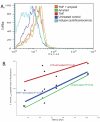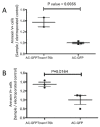Dual induction of TREM2 and tolerance-related transcript, Tmem176b, in amyloid transgenic mice: implications for vaccine-based therapies for Alzheimer's disease
- PMID: 20640189
- PMCID: PMC2905103
- DOI: 10.1042/AN20100010
Dual induction of TREM2 and tolerance-related transcript, Tmem176b, in amyloid transgenic mice: implications for vaccine-based therapies for Alzheimer's disease
Abstract
Vaccine-based autoimmune (anti-amyloid) treatments are currently being examined for their therapeutic potential in Alzheimer's disease. In the present study we examined, in a transgenic model of amyloid pathology, the expression of two molecules previously implicated in decreasing the severity of autoimmune responses: TREM2 (triggering receptor expressed on myeloid cells 2) and the intracellular tolerance-associated transcript, Tmem176b (transmembrane domain protein 176b). In situ hybridization analysis revealed that both molecules were highly expressed in plaque-associated microglia, but their expression defined two different zones of plaque-associated activation. Tmem176b expression was highest in the inner zone of amyloid plaques, whereas TREM2 expression was highest in the outer zone. Induced expression of TREM2 occurred co-incident with detection of thioflavine-S-positive amyloid deposits. Transfection studies revealed that expression of TREM2 correlated negatively with motility, but correlated positively with the ability of microglia to stimulate CD4(+) T-cell proliferation, TNF (tumour necrosis factor) and CCL2 (chemokine ligand 2) production, but not IFNgamma (interferon gamma) production. TREM2 expression also showed a positive correlation with amyloid phagocytosis in unactivated cells. However, activating cells with LPS (lipopolysaccharide), but not IFNgamma, reduced the correlation between TREM2 expression and phagocytosis. Transfection of Tmem176b into both microglial and macrophage cell lines increased apoptosis. Taken together, these data suggest that, in vivo, Tmem176b(+) cells in closest apposition to amyloid may be the least able to clear amyloid. Conversely, the phagocytic TREM2(+) microglia on the plaque outer zones are positioned to capture and present self-antigens to CNS (central nervous system)-infiltrating lymphocytes without promoting pro-inflammatory lymphocyte responses. Instead, plaque-associated TREM2(+) microglia have the potential to evoke neuroprotective immune responses that may serve to support CNS function during pro-inflammatory anti-amyloid immune therapies.
Keywords: Aβ, amyloid β peptide; CCL2, chemokine ligand 2; CFSE, carboxyfluorescein succinimidyl ester; CNS, central nervous system; Clast1; DAMP, danger-associated molecular pattern; DMEM, Dulbecco's modified Eagle's medium; EAE, experimentally induced autoimmune encephalomyelitis; FBS, fetal bovine serum; GFP, green fluorescent protein; HPRT, hypoxanthine phosphoribosyl transferase; IFNγ, interferon γ; IL, interleukin; KO, knockout; LPS, lipopolysaccharide; PFA, paraformaldehyde; TNF, tumour necrosis factor; TREM2, triggering receptor expressed on myeloid cells 2; Thio-S, thioflavine-S; Tmem176b, transmembrane domain protein 176b; Torid; WT, wild-type; antigen presentation; autoimmunity; neuroinflammation; qPCR, quantitative PCR.
Figures










References
-
- Afagh A, Cummings BJ, Cribbs DH, Cotman CW, Tenner AJ. Localization and cell association of C1q in Alzheimer's disease brain. Exp Neurol. 1996;138:22–32. - PubMed
-
- Bianchin MT, Capella HM, Chaves DL, Steindel M, Grisard EC, Ganev GG, da Silva Júnior JP, Neto Evaldo S, Poffo MA, Walz R, Carlotti Júnior CG, Sakamoto AC. Nasu-Hakola disease (polycystic lipomembranous osteodysplasia with sclerosing leukoencephalopathy–PLOSL): a dementia associated with bone cystic lesions. From clinical to genetic and molecular aspects. Cell Mol Neurobiol. 2004;24:1–24. - PMC - PubMed
-
- Brynskikh A, Warren T, Zhu J, Kipnis J. Adaptive immunity affects learning behavior in mice. Brain Behav Immun. 2008;22:861–869. - PubMed
-
- Butovsky O, Bukshpan S, Kunis G, Jung S, Schwartz M. Microglia can be induced by IFN-γ or IL-4 to express neural or dendritic-like markers. Mol Cell Neurosci. 2007;35:490–500. - PubMed
Publication types
MeSH terms
Substances
Grants and funding
LinkOut - more resources
Full Text Sources
Other Literature Sources
Medical
Research Materials
Miscellaneous

